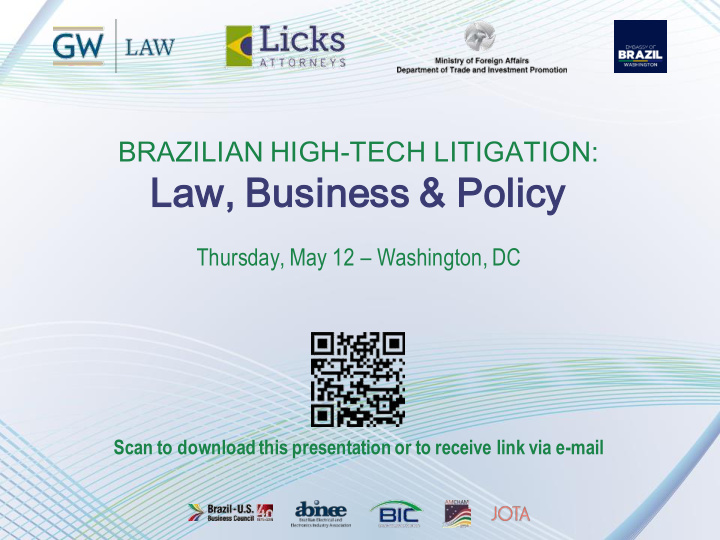



BRAZILIAN HIGH-TECH LITIGATION: Law, Business & Policy Thursday, May 12 – Washington, DC Scan to download this presentation or to receive link via e-mail
Pharma and Biotech ch Patents s Prose secu cutio ion: Examin inin ing guideli lines s and fast-track ck examin inatio ion Luiza Cotia Pharmacist and Patent Specialist BRAZILIAN HIGH-TECH LITIGATION: Law, Business & Policy The George Washington University Law School
Pharma and Biotech Patents Prosecution Examining guidelines and fast-track examination Luiza Cotia, Pharmacist and Patent Specialist Thursday, May 12 – Washington, DC
Fast-track examination
The Brazilian Patent Office • The Brazilian Patent Office (BRPTO) • Strong influence of the EPO • Training by the WIPO in the 1980’s • Examiners will often study the examination of the EPO patent family • Major problems of the BRPTO • Infrastructure • Budget • Inefficiency • Huge backlog (average 10 years for starting to examine a patent application) 5
Overcoming the backlog: pharma fast-track • BRPTO prioritized examination programs applicable to pharma and biotech patent applications • GENERAL (Rule #151/2015) : fast-track examination of applications covering: 1. Technology being used by unauthorized third parties (ongoing or potential infringement activity) (requested by the applicant); 2. Technology of public interest (requested by the Government); • PHARMA (Rule #80/2013): fast-track examination of applications related to the diagnosis, prevention or treatment of HIV, cancer or neglected diseases; 6
Overcoming the backlog: pharma fast-track • The Ministry of Health and Rule #80/2013 • Rule #80/2013 also provides the possibility of prioritized examination of patent applications covering products, process and medical devices considered strategic to SUS (art. 3 of the Rule). • The patent applications are not related only to the diagnosis, prevention or treatment of HIV, cancer or neglected diseases. • The Ministry of Health has never used this fast-track possibility. • On April 16 2015 a cooperation program between the BRFDA and the Fiocruz was approved (Proceeding #25351.538402/2014-3) • The Cooperation program has the goal of identifying pending patent applications that should be requested by the Ministry of Health to be placed under priority examination by the BRPTO. 7
Overcoming the backlog: Our strategic counseling • 1,832 priority examination requests in total. • 95 are patent applications covering pharma inventions. • 69 priority examinations granted for pharma applications. • Only 26 applications using Rule #80/2013 -> 10 applications (39%) are being handled by Licks. • The decision granting the priority examination request is published within 35 to 50 days. • After granting the priority examination, the BRPTO takes between 3 to 5 months to forward the application to BRFDA for prior approval. 8
Claiming biotech and pharma inventions
Claiming biological molecules • The whole or part of natural living beings and biological materials found in nature represent non-statutory subject matter (art. 10, line IX of Statute #9,279/96): • Synthetic molecules vs. natural counterparts; • Composition comprising natural molecules or synthetic molecules identical to the natural molecules and water and saline as excipients are not patentable (art. 10, IX); • Latter published documents may be used to show that the molecule is of natural occurrence. • Living beings, in whole or in part, except transgenic microorganisms meeting the three patentability requirements, also represent non-statutory subject matter (art. 18, line III of Statute #9,279/96): • Microorganims are bacteria, archaea, fungus, single-cell algae not classified in the Plant Kingdom and protozoaria. 10
Claiming biological molecules • DNA must be defined through its nucleotide sequence: • A DNA sequence cannot be described by its hybridization process. • Protein must be defined through its amino acid sequence; • Biologic molecules cannot be claimed by its function; • Derivatives are permitted as long as the amino acid substitution, deletion, addition or insertion are defined by the amino acid sequence. This can be used to avoid application of art. 10, line IX; 11
Claiming biological molecules • Polyclonal antibodies are biological products isolated from nature and, thus, represent non-statutory subject matter (art. 10, IX of Statute #9,279/96); • Monoclonal antibodies are considered as statutory subject matter: • Monoclonal antibodies must be claimed by its sequence identification number or by its hybridoma; • The hybridoma must be clearly defined in the specification, or the deposit number of the hybridoma must otherwise be informed. The hybridoma must be filed until the filing or priority date of the application; • The BRPTO recognizes only depository authorities indicated under the Budapest Treaty. 12
Claiming pharma inventions • Patent examination guidelines of 2015 (item 3.79 – block I) => the acceptable format for claiming a medical use invention is the Swiss-type. • Swiss- type: “ use of compound X in the manufacture of a medicine/composition for treating condition Y ” • The BRPTO will probably follow the EPO rules. • Suggestion: Including both Swiss- type claims and “EPC 2000” claims . • EPC2000: “Compound X for use in the treatment of condition Y” 13
Claim amendments
Claim amendments • BRPTO strict position when the applicant perform amendments after the examination request • BRPTO issued Rule #93/2013 regarding articles 26 and 32 of the Statute #9,279 on claim amendments; • Before the request of substantive examination, any amendment on the specification, abstract, drawings or claims is acceptable if it is limited to the subject matter disclosed in the originally filed application; • After the request of substantive examination only amendments intended to restrict the claimed matter or to correct clerical and translation mistakes are acceptable. • Suggestion: Including an omnibus claim . • “ Invention of product, process, system or use characterized by all their elements disclosed in the application. ” 15
Thanks! luiza.cotia@lickslegal.com T +55 21 3550-3792 M +55 21 99457-3549
Recommend
More recommend